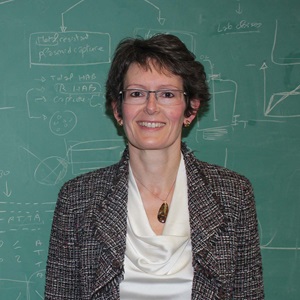Eva Top
Eva Top
Professor Emerita
Life Sciences South 258
208-885-5015
Dept. of Biological Sciences
University of Idaho
875 Perimeter MS 3051
Moscow, Idaho 83844-3051
Research: Biomedical Science, Ecology & Evolutionary Biology
- Ph.D. Agricultural Sciences, Ghent University, 1993
- B.S./M.S. Bioengineering, Ghent University, 1989
My research is currently focused on the evolution and ecology of plasmids that transfer to and replicate in a broad range of bacteria. Plasmids are mobile genetic elements found in most bacteria. Because they readily transfer between different types of bacteria under natural conditions, they play an important role in rapid bacterial adaptation to changing environments. A good example is the current epidemic of multiple antibiotic resistance in human pathogens, which is largely due to the spread of multi-drug resistance plasmids. Although plasmid-mediated gene transfer is now recognized as a key mechanism in the alarming rise of antibiotic resistance, little is known about their host range, their ability to invade bacterial populations in the absence of selection, and their genetic diversity. We are addressing these questions using various Proteobacteria and plasmids as model systems.
Dr. Top's lab is a member of Biology, Institute for Bioinformatics and Evolutionary Studies (IBEST) and the Bioinformatics & Computational Biology (BCB) Graduate Programs.
- Plasmid-Host Interaction and Evolution of Plasmid Host-Range
Since rapid plasmid-mediated spread of multi-drug resistance to human pathogens is threatening our ability to fight against infectious diseases, we urgently need novel therapies aimed at limiting the spread of new resistance genes. However, little is known about what determines the range of bacteria in which a plasmid can be maintained. Moreover we do not know if and how, and at what tempo that host range can expand, contract or shift over time. Since bacteria evolve very rapidly their drug resistance plasmids can also quickly adapt to novel hosts by reducing their cost and becoming more stable even in the absence of the drugs. The new project aims at discerning patterns of plasmid host range evolution in bacteria through (i) experimental evolution studies followed by (ii) molecular and biochemical analysis of evolved plasmids, and (iii) mathematical and statistical modeling of the evolutionary processes. For example, we found that the stability of a drug resistance plasmid in a novel host can rapidly improve in bacterial populations through mutations in the plasmid alone, the host chromosome alone, or both, and that a single mutation in a plasmid can have a dramatic effect on its host range. This project is in collaboration with Dr. Zaid Abdo and funded by the National Institute of Allergies and Infectious Disease (NIAID) of the National Institutes of Health (http://www.niaid.nih.gov). - Evolution of plasmid persistence in biofilms
A second project was recently funded by the Department of Defense, through a Military Infectious Diseases Basic Research Award. Infections of wounds incurred in combat greatly threaten the lives of those who survive the first hours after injury. Hospital acquired infections of combat wounds in military treatment facilities and other nosocomial infections present a major health crisis today because they are commonly caused by multi-drug resistant (MDR) bacteria. These bacteria also form biofilms in the wounds, which renders them even more resistant. Unfortunately, biofilms are also considered ‘hot-spots’ for plasmid transfer, and plasmids can in turn promote biofilm formation. The goal of the proposed research is to gain insight into the evolutionary mechanisms by which drug resistance plasmids can improve their persistence in biofilms formed by bacteria known to cause wound infections. The central hypothesis is that the evolutionary pathways through which plasmid persistence improves are different and more varied in biofilms than in well-mixed liquids due to the spatially structured environment of biofilms that is absent in liquids - The Genetic Diversity of Broad-host-Range Plasmids in Bacteria
A third project aims at enhancing our understanding of the diversity and evolutionary history of the extant pool of BHR plasmids. This is done by comparative genomic and phylogenetic analysis of the complete genome sequences of natural plasmids. This project was funded by the National Science Foundation, and the DNA sequencing service has been provided by Department of Energy Joint Genome Institute. Co-investigators are Professors Celeste Brown, Jack Sullivan, and Larry Forney. Future research will focus on the evolutionary history of plasmids: What are the current plasmids' long-term host reservoirs, and do plasmids evolve mostly by vertical descent or through lateral exchange of core genes between plasmids?
- 1989 Prize of the Alumni Society of Agricultural Engineers for academic achievement and community service (in Dutch: ‘de meest verdienstelijke student’; out of ca. 100 seniors, Ghent University, Belgium)







